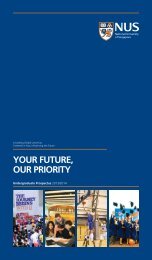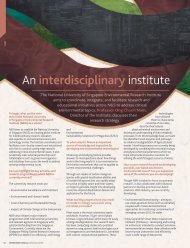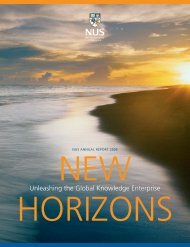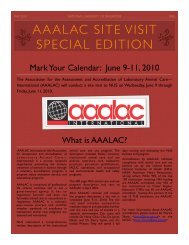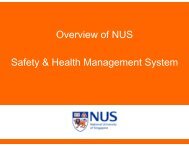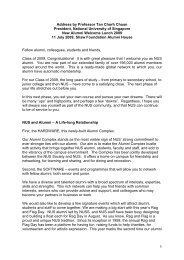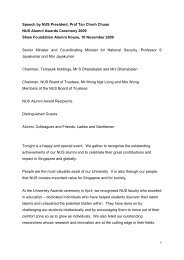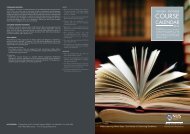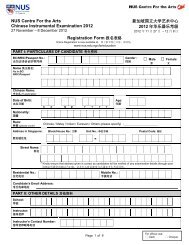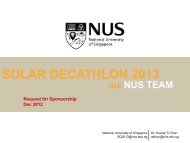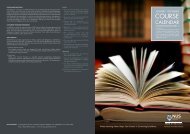3. RESOURCES - NUS - Home
3. RESOURCES - NUS - Home
3. RESOURCES - NUS - Home
You also want an ePaper? Increase the reach of your titles
YUMPU automatically turns print PDFs into web optimized ePapers that Google loves.
CONSERVATORY STUDENT HANDBOOK 2012/2013<br />
<strong>3.</strong> <strong>RESOURCES</strong><br />
<strong>3.</strong>1 OPENING HOURS<br />
<strong>3.</strong>1.1 Conservatory Building<br />
(During Semesters)<br />
Monday – Sunday:<br />
(Including Public Holidays)<br />
6:00 AM to 12:00 Midnight<br />
Entrance to most areas of the building is by card access only. Opening hours<br />
during the vacations will be shorter.<br />
<strong>3.</strong>1.2 Administration Offices<br />
Tel: 6516-1167<br />
Fax: 6872-6915<br />
(During Semesters)<br />
Monday - Thursday:<br />
Friday:<br />
Saturday, Sunday:<br />
& Public Holidays<br />
8:30 AM to 6:00 PM<br />
8:30 AM to 5:30 PM<br />
Closed<br />
<strong>3.</strong>1.3 Music Library<br />
Tel: 6516-8130<br />
(During Semesters)<br />
Monday - Friday: 8.00 AM to 6.00 PM (Week 1 – 13)<br />
8:00 AM to 8.00 PM (Week 14 - 16)<br />
Saturday:<br />
9.00 AM to 6.00 PM<br />
Sunday: Closed (Week 1 – 12)<br />
11.00 AM to 6.00 PM (Week 13 – 16)<br />
Public Holidays: Closed (Week 1 – 12)<br />
11.00 AM to 6.00 PM (Week 14 – 16)<br />
(During Vacations)<br />
Monday - Friday:<br />
8.30 AM to 6.00 PM<br />
Saturday Sunday:<br />
Closed<br />
& Public Holidays<br />
<strong>3.</strong>1.4 Security Office<br />
Opening Hours – round the clock, 7 days a week.<br />
Conservatory Building Security<br />
Tel: 6516-7476<br />
Campus Security<br />
Tel: 6516-1616<br />
10
CONSERVATORY STUDENT HANDBOOK 2012/2013<br />
<strong>3.</strong>2 FACILITIES<br />
Officially opened in 2006, the Yong Siew Toh Conservatory of Music Building<br />
houses state-of-the-art facilities for training professional musicians. These<br />
include a 600-seat concert hall, approximately 80 sound-proof and<br />
temperature controlled studios and practice spaces, a music library, smart<br />
classrooms, and one of the largest recording studios in Asia.<br />
The building, designed by RSP Architects Planners and Engineers, exploits<br />
the brightness of the tropical environment through the use of glass panels<br />
which allow natural light into as many spaces as possible. The main façade is<br />
fronted by full-length glass panels which offer views into the foyer of the<br />
concert hall and library. The glass walls are supported by paired bow trusses<br />
which look like the strings on a violin or cello. Another interesting aspect of<br />
the design is that the outer walls are concave in nature enabling non-parallel<br />
walls (acoustically ideal) to be a constant feature of the internal architecture.<br />
<strong>3.</strong>2.1 Conservatory Concert Hall<br />
The 600-seat concert hall is purpose-built for classical music performances,<br />
and is an ideal venue for chamber music as well as for symphony orchestra<br />
concerts. The narrower width of the seating area in the stalls creates an<br />
intimate feel, which opens up to embrace the curve of the stage. Sound<br />
reflectors above the stage allow the acoustic height of the room to be<br />
adjusted for different performances.<br />
The rectangular “shoe-box” shape of the hall is also found in world-class<br />
concert halls such as Symphony Hall in Boston, Amsterdam’s<br />
Concertgebouw and the Musikverein in Vienna. The surface finishes were<br />
chosen for both architectural and acoustical value. One of the most<br />
interesting details is the balcony front, which is made of maple wood. Its<br />
curved surfaces help to homogenize the hall’s acoustics, while the grooves of<br />
varying depths diffuse sound waves to every corner of the room. The wavy<br />
finishes of the wall panels create a similar diffusion effect.<br />
The hall was designed by German consultant Eckhard Kahle of Kahle<br />
Acoustics, in collaboration with UK-based Theatre Projects Consultants.<br />
<strong>3.</strong>2.2 Conservatory Orchestra Hall<br />
The Orchestra Hall is an alternative performance venue suitable for chamber<br />
music and solo recitals. Its acoustically treated walls and absence of<br />
structural columns also make it an ideal space for large ensemble rehearsals.<br />
<strong>3.</strong>2.3 Steven Baxter Recital Studio<br />
The Steven Baxter Recital Studio is an intimate performance space suitable<br />
for chamber music, solo recitals and lectures. It seats an audience of 80 and<br />
is fully equipped to support video conferencing.<br />
<strong>3.</strong>2.4 Teaching Studios<br />
These studios are where students have their Applied Major Study lessons.<br />
11
CONSERVATORY STUDENT HANDBOOK 2012/2013<br />
<strong>3.</strong>2.5 Practice Rooms<br />
These rooms are subject to heavy use and measures are in place to ensure<br />
that these rooms are for practice and rehearsal only. Students can reserve<br />
practice room times a week in advance.<br />
<strong>3.</strong>2.6 Seminar Rooms<br />
Seminar Rooms are smart classrooms that are equipped with Ethernet, digital<br />
and analog audio-visual equipment, such as DVD and CD players, iMac<br />
computers, digital visual presenters, video projectors, high quality screens,<br />
and more.<br />
<strong>3.</strong>2.7 Ensemble Rooms<br />
Ensemble Rooms are to be used for rehearsals for chamber ensembles,<br />
sectionals for large ensembles, studio classes and other larger ensemble<br />
rehearsals. All ensemble room bookings are scheduled by the Concerts &<br />
Events Office and the Academic Affairs Office.<br />
<strong>3.</strong>2.8 Recording Studio<br />
The Conservatory Recording Studio is one of the most comprehensive<br />
studios in any educational facility in the world. It is linked to the<br />
Conservatory’s Concert Hall as well as to the Recital Studio and Orchestra<br />
Hall. The latest studio diffusion technology from RPG diffuser Inc. makes this<br />
floating construction, variable acoustical environment extremely ideal for<br />
either classical or modern music production.<br />
<strong>3.</strong>2.9 Keyboard Lab<br />
The Keyboard Lab is equipped with Yamaha Clavinova keyboards and<br />
Macintosh iBooks that integrate technology into teaching.<br />
<strong>3.</strong>2.10 Music Technology Lab<br />
The Music Technology Lab is equipped with iMac computers and M-Audio<br />
keyboard controllers plus software that enable students to learn<br />
notation/sequencing applications as well as building websites and<br />
incorporating technology in their learning.<br />
<strong>3.</strong>2.11 Computer Room<br />
The Computer Room is for students to use to access the University’s website,<br />
prepare written assignments, research, and to use their e-mail accounts.<br />
These computers can be used to book practice rooms.<br />
<strong>3.</strong>2.12 Student Lounge<br />
The Student Lounge is located on the 3 rd floor of the Conservatory building,<br />
opposite the Orchestra Hall. The lounge is a facility for students to eat, drink<br />
and relax in between classes and rehearsals.<br />
12
CONSERVATORY STUDENT HANDBOOK 2012/2013<br />
<strong>3.</strong>2.13 Faculty Lounge<br />
The Faculty Lounge is located on the third floor of the building near the<br />
teaching studios. Card access is restricted to faculty members only. Students<br />
are not allowed in this area under any circumstances.<br />
<strong>3.</strong>2.14 Music Library<br />
Music books, scores, CDs and DVDs are kept in the Music Library. Student<br />
matriculation cards serve as library cards for checking out materials.<br />
LINC (http://linc.nus.edu.sg) is the online catalog for the entire collection of<br />
the <strong>NUS</strong> libraries. It allows users to search for materials by title, author,<br />
composer, subject or musical instrument. Check LINC to find the call number<br />
and the exact location of the books/scores in the library. LINC terminals are<br />
located on both floors of the Music Library.<br />
Music books and study/full scores are kept on the open shelves on the 2nd<br />
floor of the Music Library. These materials are shelved by call numbers.<br />
Students may check out books and scores at the Loan Counter on the 1st<br />
floor or at the self-service machine near the library entrance/exit.<br />
Chamber music scores in parts, CDs, and DVDs are kept behind the Loan<br />
Counter. To check out these materials, students need to record the Stack<br />
Number from LINC before requesting for them at the Loan Counter. Individual<br />
parts of chamber music scores may be checked out separately. Listening and<br />
viewing stations for CDs/DVDs are available on the same floor. Reserved<br />
readings and listening materials (RBR or red spot materials) are also kept<br />
behind the Loan Counter.<br />
Electronic journals, encyclopedias and indexes/abstracts can be accessed via<br />
the workstations located on the 1st floor of the Music Library near the LINC<br />
terminals.<br />
These resources can also be accessed from any PCs or laptops in campus<br />
by going to the Library Portal (http://www.lib.nus.edu.sg). Access from home<br />
is also possible.<br />
<strong>3.</strong>2.15 Printing Facilities<br />
Cashcard printing facilities are available at the Computer Room and at the<br />
Music Library.<br />
<strong>3.</strong>2.16 The Workshop<br />
The Workshop is home to the the Balinese Gamelan which is used for the<br />
Music in the Global Context course as well as Professional Development<br />
programmes. It is decorated with many traditional Balinese items including<br />
masks and a variety of paintings, offering a unique environment in which to<br />
pursue creative work. The Workshop has full facilities to present lectures,<br />
such as a computer, visualizer, projector, and a quality sound system. It can<br />
accommodate an audience of up to 40 for intimate performances.<br />
13
CONSERVATORY STUDENT HANDBOOK 2012/2013<br />
<strong>3.</strong>3 INSTRUMENTS<br />
Musical instruments owned by the Conservatory are available for students to<br />
borrow, subject to availability and faculty recommendation. These instruments<br />
can only be used within the premises of the Conservatory or for the purpose<br />
of instrumental classes and ensemble rehearsals and/or performances.<br />
The Conservatory will loan out instruments to students for their participation<br />
in international competitions and professional engagements that are<br />
endorsed by the Conservatory on a case-by-case basis.<br />
At the end of the first semester, all Conservatory musical instruments must be<br />
checked in and inspected for care, condition, and necessary repairs. After<br />
the instruments have been inspected, students will be allowed to check out<br />
the Conservatory music instruments over the holiday break as long as the<br />
instruments are not taken out of the Conservatory Building.<br />
At the end of the second semester, all Conservatory musical instruments<br />
must be checked in for repair and maintenance. No musical instruments may<br />
be checked out over the vacations unless the student has the approval of the<br />
student’s Applied Major Study teacher and the Conservatory Director.<br />
<strong>3.</strong>4 EQUIPMENT<br />
<strong>3.</strong>4.1 Lockers<br />
Instrument and book lockers are located on the second floor of the<br />
Conservatory building. These lockers are reserved only for music majors<br />
enrolled in regular classes at the Conservatory. Most students will be<br />
assigned an instrument locker and a book locker for his/her exclusive use in<br />
each academic year. Exchanging of lockers is not permitted. The<br />
Conservatory is not responsible for the loss of or damage to property stored<br />
in the assigned locker. The Conservatory reserves the right to inspect lockers<br />
at any time.<br />
<strong>3.</strong>4.2 Music Stands and Chairs<br />
Music stands and chairs belong to the Conservatory. Stands and chairs<br />
allocated to any room must remain in that room. Any equipment taken out of<br />
the rooms must be returned to the same room at the end of the rehearsal<br />
session. No music chairs and stands are to be removed from the<br />
Conservatory Building.<br />
14
CONSERVATORY STUDENT HANDBOOK 2012/2013<br />
<strong>3.</strong>5 RECORDING SERVICES<br />
<strong>3.</strong>5.1 Bookings<br />
<strong>3.</strong>5.2 Fees<br />
a) Online Submission Request must be submitted for all Duplication<br />
Requests/Recording Session bookings. The online form can be found at<br />
the following webpage<br />
http://scmapp.nus.edu.sg/recordingstudio/requestform.aspx<br />
b) Recording Studio Manager will contact students after receiving the online<br />
request for confirmation of Recording date and time.<br />
c) For Duplication requests, Recording Studio Manager will contact you<br />
when CDs/ DVDs are ready for collection.<br />
d) Cash Payment must be made at Level 1 Admin Office before collection<br />
of CDs/ DVDs. Students are required to retain Official Receipt as proof of<br />
payment made and present this to the Recording Studio Manager when<br />
collecting their CDs/DVDs.<br />
All bookings require a 2-week notice and a one-hour minimum booking is<br />
required for any Recording session. A 50% deposit is required and is nonrefundable<br />
for the sessions cancelled with less than 24-hour notice. Rates<br />
include the use of the recording studio and a student engineer (studio<br />
manager’s rates are double).<br />
Students who prefer to record in one of the halls must pay a hall rental fee, in<br />
addition to a recording fee.<br />
(for current students)<br />
2 track recording S$50 per hour<br />
Editing and Mastering S$50 per hour<br />
Multi-track recording S$100 per hour<br />
Multi-track Mixdown S$100 per hour<br />
DVD Authorization S$50 per hour<br />
Non-degree recital S$50 (flat fee)<br />
All recordings at the Conservatory are under the purview of the YSTCM<br />
Recording Studio. The studio is not for use as a rehearsal or practice facility<br />
and is off-limits to all faculty, staff and students unless accompanied by the<br />
Recording Studio Manager. The operation of the studio and all associated<br />
equipment is limited to the Recording Studio Manager and his designees<br />
only.<br />
In addition, the Recording Studio equipment and supplies are for use in the<br />
Recording Studio only and may not be loaned out to anyone for any purpose<br />
except with the express written consent of the Director of the Conservatory.<br />
15
CONSERVATORY STUDENT HANDBOOK 2012/2013<br />
<strong>3.</strong>5.3 Recital, Chamber Music and Ensemble Recordings<br />
All degree recitals (except junior recitals), performances in the Concert<br />
Calendar, noon recitals, senior and ensemble performances are recorded.<br />
All degree recitals (except junior recitals), are recorded for free. Students may<br />
obtain copies of their recitals and other public performances by placing an<br />
audio duplication request through the Recording Studio Office. Conductors<br />
and soloists of large ensembles may obtain a free copy of their performances<br />
by placing an audio duplication request and indicating whether they were a<br />
conductor or soloist in the performance.<br />
Students who wish to have their non-degree or junior recitals recorded by the<br />
Recording Studio are required to pre-pay a flat fee of S$50. A fee for nondegree<br />
recitals that are over 60 minutes long will be determined by the<br />
Recording Studio Manager. To schedule a non-degree recital recording,<br />
please contact Mr Zhou Xiaodong at xdzrec@nus.edu.sg<br />
Video recordings are available on special request for the non-degree or junior<br />
recitals. For rates and scheduling of video recordings, please contact Mr<br />
Zhou Xiaodong at xdzrec@nus.edu.sg<br />
<strong>3.</strong>5.4 Audio Duplication Fees<br />
1 CD/DVD S$10 each<br />
2 CDs/DVDs S$20 each<br />
Additional copy<br />
S$5 each<br />
(of the same performance)<br />
Audio duplication fees include materials and services. Editing is not included<br />
in the fees (performers who require editing will be charged S$50 per hour).<br />
High-volume duplications (additional copies of the same performance) are<br />
available.<br />
Duplications will be completed within 10 working days. Rush duplications<br />
(within 3 working days) will include an additional fee of 25% of the cost. Prepayment<br />
is required prior to the order being processed.<br />
Note: Most large ensemble concerts span 2 or more CDs.<br />
7% GST is chargeable.<br />
16
CONSERVATORY STUDENT HANDBOOK 2012/2013<br />
<strong>3.</strong>6 SECURITY<br />
<strong>3.</strong>6.1 Instruments, Equipment and Personal Belongings<br />
In the interest of security of instruments and equipment, the Conservatory has<br />
installed cameras at various locations within the building as well as other<br />
various security measures. Security officers patrol the Conservatory building<br />
regularly during and after office hours each day, including weekends and<br />
public holidays. Lost and Found items can be given to or retrieved from the<br />
Security Office located in the Concert Hall foyer. Please note that the<br />
Conservatory is not liable for loss of any musical instruments or personal<br />
belongings.<br />
<strong>3.</strong>6.2 Visitors<br />
All visitors to the Conservatory are required to sign in at the Fire Command<br />
Center (FCC) located in the Concert Hall foyer. Faculty staff and students are<br />
responsible for their visitors, who should be accompanied at all times during<br />
their visit to the Conservatory. It is important that any suspicious persons and<br />
intruders be reported immediately to the security personnel or any<br />
Conservatory staff member immediately.<br />
<strong>3.</strong>6.3 Fire Safety<br />
The person who discovers the fire shall immediately:<br />
(a) Raise the alarm by activating the nearest fire alarm “break-glass” call<br />
point.<br />
(b) Assist in evacuating people from the immediate area of smoke and/or<br />
fire.<br />
(a) Notify Conservatory Security (Tel No: 6516-7476), Campus Security (Tel<br />
No: 6516-1616) and Singapore Civil Defence Force (Tel No: 995).<br />
(b) Close all doors to rooms, escape staircase and corridors to contain the<br />
smoke and/or fire.<br />
In the event of a fire emergency, audio and visual alarms will activate<br />
throughout the building. Please leave your personal belongings and musical<br />
instruments in the rooms and exit the building via the nearest fire escape exit.<br />
Fire Wardens, identified by their bright orange safety vests, will be mobilized<br />
to guide in the evacuation. Please follow their directions at all times.<br />
<strong>3.</strong>6.4 Emergency<br />
Campus security can be approached for assistance in any emergency<br />
through the 24-hour hotline 6516-1616. In an emergency situation where<br />
serious injury is involved, call 995 for an ambulance. Basic first aid kits are<br />
available at the following locations: 1 st storey – Security Office, Admin Office,<br />
Director’s Wing, Music Library and 3 rd storey – Faculty Lounge<br />
17



